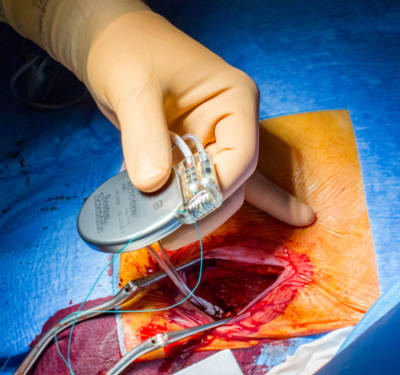The downside of cardiac devices insertion
Cardiac devices implantation have increased rapidly, but more research is needed to determine if it does not have serious side effects.
Published online 30 November 2015

Automatic defibrillator implantation.
© Phanie / Alamy Stock Photo
In the past decade, there has been a significant worldwide increase in the implantation of cardiac devices such as permanent pacemakers, cardiac defibrillators, and biventricular pacemakers, and this trend is likely to continue because of increasing life expectancy.
One potential complication following the implantation of such devices is tricuspid valve regurgitation (TR), in which the tricuspid valve does not close properly, causing blood to leak back into the right ventricle of the heart. This is thought to be due to interference of the valve's function by the permanent endocardial leads that control the implanted devices.
There is, however, little information about the prevalence of TR, or about the exact mechanisms by which it occurs. Hisham Dokainish of McMaster University in Ontario, Canada, and colleagues are therefore performing a prospective study to determine how prevalent TR is after pacemaker lead insertion, its potential underlying mechanisms, and whether it is of any clinical importance to cardiac patients1.
So far, the researchers have recruited 300 patients from centres in Canada and Europe. Of these, 154 had a permanent pacemaker implanted, 102 received implantable cardiac defibrillators, and 44 received biventricular pacemakers.
The researchers are currently documenting the percentage of time for which each patient is being paced, and the position of the leads attached to their implants, among other clinical factors. Echocardiography will be performed at a mean of one year post-pacemaker insertion to assess whether there is an increase in TR after lead implantation.
Given that patient follow-up after pacemaker insertion is still ongoing, it remains unclear whether permanent implantation of a cardiac device increases the risk of TR. The researchers believe that their study should help to answer these questions as patient follow-up is completed. However, if TR is indeed found to be associated with device implantation, this could have a major impact on how these procedures are performed, and could also provide a rationale for developing less invasive treatments for patients with heart rhythm disorders.
“Patient follow-up is projected to be complete by end of March 2016,” says Dokainish. “If TR is indeed shown to increase following lead implantation post-pacemaker insertion, and if in some patients the TR is severe and significantly affecting clinical symptoms, corrective surgery could be considered.”Reference
- Dokainish, H. et al. Prospective study of tricuspid valve regurgitation associated with permanent leads in patients undergoing cardiac rhythm device implantation: background, rationale, and design. Glob. Cardiol. Sci. Practice2015, 41 (2015). | article
DOI: 10.1038/qsh.2015.87

